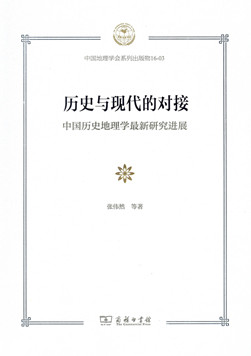Historical geography: breakthrough, reflection
Author : DING YANNAN Source : Chinese Social Sciences Today 2017-02-14

Connection of History and Modernity: The Latest Research Progress of Chinese Historical Geography
Author: Zhang Weiran et al
Publisher: The Commercial Press
Connection of History and Modernity: The Latest Research Progress of Chinese Historical Geography was published when the 33rd International Geographical Congress was held in August, 2016 in Beijing. This was the first time China hosted this world-class event, marking a historic moment in the development of China’s geographical studies.
The book summarizes the academic achievements of Chinese historical geography since it began in 1934, including natural, political, economic, demographic, urban, cultural perspectives of historical geography, and discusses Chinese contributions to historical geography in terms of academic disciplines.
For general readers, it is not easy to distinguish historical and evolutionary geography. This is also the problem Chinese historical geography has faced since its birth and has not yet fully resolved. The book begins with the views of those major historical geographers on the nature of the subject in the form of a phased review of academic history. Among the authors, Hou Renzhi was the first to realize the differences between Chinese traditional evolutionary geography and historical geography that makes sense in modern times.
Tang Xiaofeng, a professor from Peking University, once proposed that the ancient Chinese geography is a developed form of social human geography. It is difficult to form a geographic knowledge system that would be accepted by modern people. The book further confirmed this perception, emphasizing that a major feature of Chinese traditional geography is humanity. Ancient China failed to develop a systematic knowledge of physical geography, which is a generally accepted view in the research field. If pre-modern geography is tested by using the concepts and standards of modern geography, that is, “reverse analogical interpretation,” then it tends to conclude that before modern China, there was no geography. Tang then pointed out that if the background of geographical knowledge was ignored, then utilizing only a reverse analogical interpretation approach will “lose the original sophisticated connotations of ancient geography.” The book also states that the value of Chinese historical geography cannot be fully covered by Western geographical paradigms formed in modern times.
Material and epistemology determine that Chinese historical geography has a unique theory and research paradigm. The book argues that, on the one hand, China’s traditional geography has a strong sense of humanity, and materials and information are all encyclopedic. On the other hand, contemporary geography is organized and developed in specialized branches. China’s historical geographers need to deal with long-term changes and different branches of contemporary geography. In addition to detailed research results, the book also refined the theory and research paradigm of Chinese historical geography, pointing out that the core idea is “space-time sequence,” and the core technology is “textual research.” Also, geographical field research methods have been inherited in historical geography, and GIS technology is becoming a common tool for further development of the discipline.
Ye Shengtao made Chinese fairy tales from a wilderness
Ye Shengtao (1894–1988) created the first collection of fairy tales in the history of Chinese children’s literature...
-
How northern ethnicities integrated into Chinese nation
2023-09-18
-
Mogao caves
2023-09-12
-
Mogao Grottoes as ‘a place of pilgrimage’
2023-09-12
-
Time-honored architectural traditions in China
2023-08-29
-
Disentangling the civilizational evolution of China
2023-08-28
-
AI ethics in science fiction
2023-08-23














 2011-2013 by www.cssn.cn. All Rights Reserved
2011-2013 by www.cssn.cn. All Rights Reserved